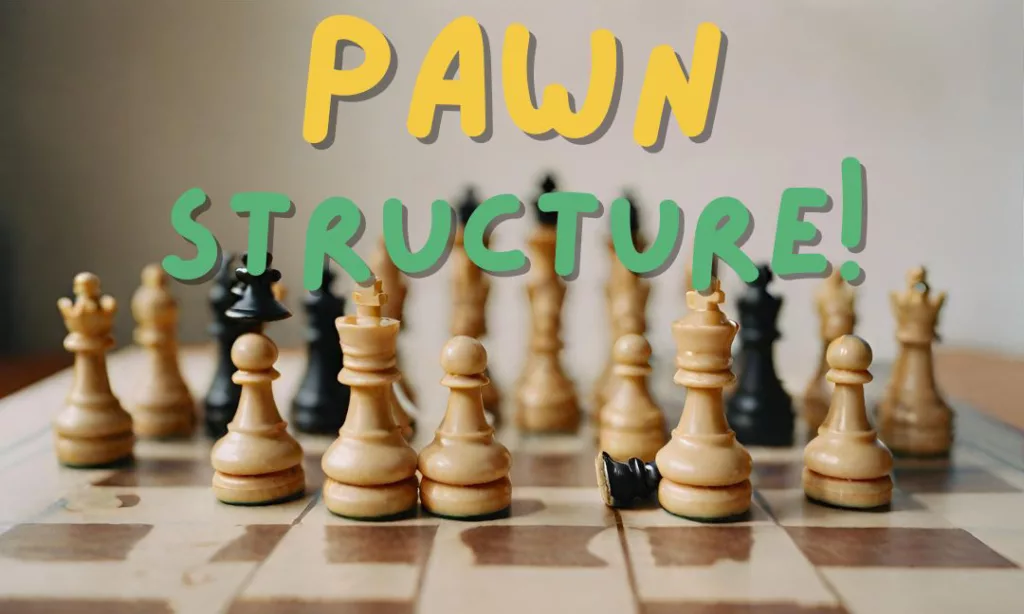Understanding pawn structure is essential for developing a strategic plan in the middlegame. Here are the top 10 most common pawn formations in chess you must know.
Chess is often likened to a battlefield, where every move carries weight and strategic planning is crucial. Amidst the tactical exchanges and positional maneuvers, the pawn structure emerges as a silent but crucial player in shaping the game’s direction. Understanding the details of pawn formations is key for players looking to gain an edge over their opponents.
Pawns, despite their limited mobility, have a big impact on the game’s dynamics. The pawn structure, also known as the pawn skeleton, acts as the backbone of a position, determining how the game unfolds. Weaknesses within the structure, like isolated or doubled pawns, can become targets for attack, while a solid pawn formation provides a stable base for launching attacks or defending key areas of the board.
It’s important to recognize that not all pawn structures are the same; their value depends on various factors like piece activity and the overall strategic context of the position. Even pawn formations that look similar can lead to very different types of play, showing the need for players to understand the details of each structure.
Carlsbad formation
This opening line gained popular during the 1923 Carlsbad tournament in Czechoslovakia, hence the name “Carlsbad pawn structure” to describe this formation. If we strip away the pieces, we can focus solely on the pawn structure.
White has the option to initiate a minority attack with moves like b4 and b5. Alternatively, White can opt for a central break with f3 and e4. If Black attempts to prevent b5 with moves like a6, White can respond with a4 followed by b5, or sometimes even a5 followed by Na4.
Black enjoys significant piece activity; for instance, the knight can maneuver to the e4 square, rooks may be lifted (Re8-e6-h6), and there’s potential for a kingside attack with moves like f7 to f5 followed by f4.
Rauzer formation
The Rauzer Formation commonly originates from openings such as the King’s Indian Defense, the Old Indian, and occasionally from the Ruy Lopez.
Black’s c-pawn contributes to a pawn chain, strengthening control over the d5 square, essential for Black’s position. In contrast, White’s c-pawn lacks such influence, making it relatively weaker. However, White benefits from a space advantage and can execute a strategic c4-c5 pawn break to further expand their control. Conversely, Black can counter with an f7-f5 pawn break to open up the position. Additionally, Black typically boasts a strong dark-squared bishop, while White may aim to dominate the d-file with their rooks
Caro formation
This formation is commonly seen in the Caro-Kann, although it can also occur in the French Defense and the Queen’s Gambit Declined, among other openings.
In the Caro Formation, White often aims for a strong outpost on e5 and enjoys a spatial advantage on the kingside. Meanwhile, Black typically focuses on attacking the isolated queen’s pawn on d4, with options for a c6-c5 or e6-e5 break.
Slav formation
The Slav Formation looks like the Caro Formation and often leads to games with a slower pace. While it typically emerges from the Slav Defense, it can also come from openings such as the Catalan, the Colle System, and the Grunfeld, among others.
In the Slav Formation, White often applies pressure on the c-file, frequently deploying a rook to c1. The thematic break for White is d4-d5 to open up the center. On the other hand, Black typically seeks to challenge White’s central pawn structure by initiating an e6-e5 or c6-c5 break.
Stonewall formation
The Stonewall Formation, often referred to as a “prison” or hexagon, is a pawn structure favored by players seeking a closed center with minimal opening theory.
In the Stonewall Formation, both sides have their pawns on one color of squares, resulting in a situation where each side has a bad bishop that they typically aim to trade off. This formation, as depicted above, features pawns encircling the e4 and e5 squares, creating a “prison”-like structure. In this setup, White can establish a good outpost for a knight on e5, while Black also has a similar outpost potential on e5.
The Stonewall Formation is most commonly seen in games arising from the Dutch Defense but can also occur from openings like the Colle System and Bird’s Opening (with colors reversed). White can initiate a kingside attack by advancing the g-pawn, as demonstrated in the game below.
Sicilian – Dragon
The Sicilian Dragon is a tactical pawn structure arising from the Sicilian Defense, characterized by Black’s setup with pawns on c5 and g6, fianchettoing the dark-squared bishop on g7. This dynamic opening leads to sharp, imbalanced positions where both sides have clear attacking prospects.
The Sicilian Dragon typically leads to either razor-sharp middlegames with opposite side castling or moderately sharp games with same side castling. Mastery of this opening demands a high level of opening memorization, especially in the Yugoslav Attack, where White employs aggressive moves like Be3, f3, Qd2, and castling queenside.
For White, key objectives include establishing a stronghold on d5, often achieved through strategic maneuvers and piece placement. Additionally, White looks to launch aggressive kingside attacks, either through a pawn storm with f2–f4–f5 after kingside castling or by advancing pawns with h2–h4–h5 following queenside castling, aiming to create weaknesses in Black’s position.
Black aims to apply pressure along the long diagonal, particularly targeting White’s pawn structure and pieces placed along this line. Black also focuses on seeking counterplay on the queenside, aiming to disrupt White’s plans and create dynamic imbalances. Moreover, Black looks to exploit any potential weaknesses in White’s overextended kingside pawns, utilizing tactical opportunities to undermine White’s position and seize control of the game. This game below will show you how Alexander Grischuk beat Magnus Carlsen in this pawn structure.
Sicilian – Scheveningen
The Sicilian Scheveningen variation, could appear in Sicilian variants such as the Najdorf, Richter–Rauzer, and Sozin, as well as the King’s English with reversed colors. It leads to a dynamic and complex middlegame. This variation is known for its sharp and detailed nature, offering both players various strategic and tactical options.
For White, the focus is on putting pressure on the d-file, making use of any space advantage, and breaking through the center, often with the e4–e5 move, following earlier moves like f2–f4. White may also opt for aggressive pawn advances on the kingside, using moves like f2–f4–f5 or the g2–g4–g5 advance seen in the Keres Attack, to disrupt Black’s position and create tactical chances.
On the other hand, Black aims to counter White’s plans by pressuring the c-file, launching attacks on the queenside, and targeting White’s central pawns, particularly those on e4 or e5. Black may also try to open up the center with moves like d6–d5 or aim for positions exploiting the weaknesses associated with the Boleslavsky hole. In this game below, Magnus Carlsen beat Hikaru Nakamura with Black in this pawn structure.
While traditionally, White avoided exchanging pieces on c6 due to concerns about strengthening Black’s center, modern chess engines have revealed nuanced approaches for White to maintain a slight advantage even in such situations. This complex interplay of ideas contributes to the engaging and fiercely contested battles that arise from the Sicilian Scheveningen variation.
Boleslavsky Hole
The Boleslavsky Hole refers to a gap on d5 created by Black’s advancement of their e-pawn. This pawn structure commonly occurs in the Sicilian Defense, particularly in variations like the Najdorf, Classical, Sveshnikov, and Kalashnikov. It can also arise from other openings such as the King’s English (with colors reversed), the Ruy Lopez, Philidor, and the Italian.
Games featuring this structure often revolve around control of the Boleslavsky Hole. If Black can effectively control this gap, they stand a good chance of gaining an advantage and winning the game.
White typically aims to target the weak backward d6 pawn and may consider initiating an f2-f4 pawn break to challenge Black’s central e5 pawn.
On the other hand, Black’s strategies often involve executing a d6-d5 pawn break and launching a minority attack on the queenside. Additionally, Black will strive to control the c4 square. However, if Black fails to adequately control the hole, White can establish a powerful outpost
d5-chain
The d5 pawn chain formation is typically associated with closed positions featuring opposite-side activity. It can emerge from various openings, including the Pirc, the Classical Variation of the King’s Indian Defense, and the Philidor.
In this structure, White enjoys a significant advantage on the queenside, while Black holds a corresponding advantage on the kingside.
White often seeks to advance with thematic pawn breaks like c2-c4-c5 and f2-f4. Meanwhile, Black’s typical pawn breaks include f7-f5, g7-g5-g4, and c7-c6.
e5-chain
This pawn structure is commonly observed in the French Defense, Advance Variation, and the Caro-Kann Advance. It can pose challenges for Black, particularly as it restricts the natural development of their knight to f6.
White’s primary objective is to initiate a kingside attack through a pawn break with f2-f4-f5. With a significant spatial advantage on the kingside, White can potentially exploit vulnerabilities around Black’s king.
Black’s strategy typically involves disrupting White’s plans for a kingside assault. This can be achieved by targeting the base of White’s pawn chain with a break like c7-c5. Additionally, playing f7-f6 helps alleviate some of the cramped conditions on the kingside while undermining White’s center, thereby facilitating Black’s piece development.
Conclusion
The pawn structure plays a vital role in shaping strategy. Understanding pawn formations is essential for players looking to navigate the complexities of the game effectively. By grasping the details of different pawn structures and their strategic implications, players can develop more nuanced and sophisticated approaches to the game, ultimately leading to success on the chessboard.

I’m a passionate board game enthusiast and a skilled player in chess, xiangqi and Go. Words for Attacking Chess since 2023. Ping me at Lichess for a game or chat.


5 thoughts on “10 Pawn Structures You Must Know”
Comments are closed.